Pestle analysis of Nike. Nike is an American multinational footwear, sportswear, equipment, and accessory company. Bill Bowerman and Phil Knight are the founders of Nike. They established the company on January 25, 1964. The headquarters of the brand is situated in Beaverton, Oregon.
Some of the main products of Nike are sports equipment, sports apparel and items, leisure footwear, athletic wear, and sports accessories. Nike has employed roundabout 75400 employees at its different production units to run various operations of the company.
Some of the main competitors of Nike in the sportswear industry are New Balance, Under Armour, Anta, Lululemon, ASICS, and Adidas.
Today, we’ll discuss the pestle analysis of Nike and how macro-environmental factors are impacting the growth of the company. If you want to learn about the internal factors of the company, check out the swot analysis of Nike. Here’s the pestle analysis of Nike;
Political Factors Impacting Nike
Trump Administration & TPP deal
When President Donald Trump came into power, he finished the TPP (Trans-Pacific Partnership) deal. The trade deal was among 12 countries like New Zealand, Australia, Canada, Mexico, and other countries on the Pacific Rim. TPP had helped many US companies like Nike to outsource their products at a lower tariff.
Impact of TPP deal
The production and manufacturing cost is very high in the US. That’s why Nike and other companies outsource their production work from the less developed countries in the Pacific Rim. According to an estimate, Nike used to manufacture 40% of its shoes and sneakers in Vietnam.
When Trump put off the TPP deal, it resulted in the form of high taxes and tariffs and lower profitability to the company. Hopefully, things will be better under the presidency of Joe Biden.
Conflict with China
The conflict between the Trump administration and the Chinese government impacted deeply the imports and exports of Nike. Trump administration imposed a lot of taxes, tariffs, and restrictions to discourage trade with China.
The import tax was mostly on consumer goods like clothes, shoes, and electronic items. The trade tension also very badly impacted the Chinese manufacturers, because they were also relying on US businesses like Nike and Walmart to export their products.
Economical factors Impacting Nike
High-Interest Rates
Nike relies heavily on debts to finance its upcoming future projects. According to an estimate, the company has a debt of 9.54 billion dollars by the end of 2020.
When we talk about debts, the interest rate also comes along with it. Whenever the Federal Reserve Bank increases the interest rate, it multiplies the current debts and future borrowing of the sportswear company. Therefore, a high interest rate makes it difficult for the company to launch and fund new projects and have an edge over competitors.
Low Profitability due to Pandemic
Nike has been performing very well for the past few years. The annual revenue of Nike in 2018 and 2019 was 36.379 billion and 39.117 billion US dollars. The annual revenue growth has been increased by approximately 5.96% and 7.47% compared to 2017 and 2018.
According to a study, the annual revenue of the sportswear company was 37.4 billion US dollars by the end of 2020. Out of which the net profit of Nike after excluding all the expenses was 2.54 billion dollars.
In short, the annual revenue and net income of Nike have decreased roundabout of 6.25% and 37.5% by the end of 2020.
Social Factors Affecting Nike
The trend of Healthy Lifestyle
The trend of living a healthier lifestyle has been increasing among people. According to a study, 74% of people say that exercising is a part of a healthier lifestyle. Out of them, 54% of the people say that they perform exercise regularly. That’s why more and more people are joining the gym and fitness clubs to improve their health.
Fitness Products
As people are becoming health conscious and joining fitness clubs, then it increases the demand for shoes, apparel, shirts, shorts, tights, and other sports accessories. It is a great opportunity for Nike to target the health-conscious market.
Impact of Lockdown
The pandemic of covid-19 has caused the lockdown and shutdown of businesses everywhere. Many sports tournaments and international events were canceled and postponed due to the pandemic. It has limited people to their houses. That’s why it has impacted the sales of the company.
Helping the Black Community
Nike launched a campaign by the name of “Don’t Do It” against the socio-cultural racism against the black community. It shows the company’s stand on ethics and morality against social injustices. It’s because of such values, that many people prefer the products of Nike.
Technological Factors Impacting Nike
Accepting Technology
The advancement in technology has influenced almost all areas of life; sportswear brand is not an exception. Whether technology is in the production processes or the tech-designed products like smart shoes that monitor your health activities. Nike has always accepted technology and it’s one of the reasons behind the success and growth of the company.
Customized NikeID tool
Nike launched an augmented reality at some of its stores in Paris in 2017. It allowed customers to design their sneakers by using the NikeID booth. It worked only in the white sneakers. The smart pixels project different colors on the sneakers so that the customer can have a real-life experience. They would choose the color accordingly. Such tools have increased customers’ satisfaction. When customers are satisfied with the company’s products, it increases brand loyalty among customers.
Robotic Technology
Nike launched robotic technology at its production/manufacturing facilities in 2017. It would serve two main purposes, first to replace the costly human labor, and second to increase productivity. The robotic technology automated many processes within the company. It reduced the delivery time and cost of the product and the company has been able to make more profit because of it.
Legal Factors Affecting Nike
Protest against Child Labor
USPS (United Students Against Sweetshop) organized a protest against the sportswear brand Nike. It was about child labor that a third-party contractor of Nike in Vietnam was employing. The children were working at a very high temperature, lowest wages, and verbal abuse. The protest attracted the attention of the public and media, and it brought negative marketing to the company.
Monitoring of WRC
An independent monitoring organization WRC (workers’ rights consortium) wanted to check the working conditions of Nike’s manufacturing units. If it had happened, then it would have cost the company a lot. Nike denied the request and the contract with WRC expired later on. Both parties moved on their separate ways.
Sexual Harassment
According to an interview by the New York Times, many women and former employees of Nike said that sexual harassment is a casual thing there. The work environment and culture of Nike aren’t safe for women.
They have also said that they even brought the issue to the attention of Nike’s HR department. They looked the other way, even knowing the whole situation. Such issues are negatively impacting the company.
Environmental Factors Impacting Nike
Waste Standards by EPA
EPA (Environmental Protection Agency) sets standards and LDR (land disposal restriction) for companies to follow. The purpose is to discourage the companies from polluting the land by dumping their waste there.
Recyclable Products
According to an estimate, 75% of the products that Nike manufactures are recyclable. The company uses scraped plastic bottles as a raw material for the production of its products. It’s Nike’s grind program. The brand uses innovative technology to produce eco-friendly and sustainable products. The company uses the nitrogen air in the sole of its shoes, it provides a comfortable feeling while walking and running.
100% Renewable Energy Programs
Nike also claims that it has been using 100% renewable clean energy at its production facilities. Mark Parker, CEO of Nike, is serious about environmental issues and wants to develop sustainable products.
Conclusion: Nike PESTLE Analysis Example Company
After a careful study of the pestle analysis of Nike and various macro-environmental factors; we have realized that the company is obeying the laws and regulations. However, different lawsuits and pending debts are serious threats to the company. The brand should find ways to address those issues.

Ahsan Ali Shaw is an accomplished Business Writer, Analyst, and Public Speaker. Other than that, he’s a fun loving person.


